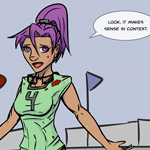For those of you that, like me, would like to point out that Phlebotinum is neither a word nor even has a strong resemblance to something that might be a word, the source of the term is, as far as I’m concerned, TV Tropes (which further details it’s origin).
TV Tropes is a fairly peculiar site. I’ve been flipping through it recently since someone linked me the article on my comic. I’m not sure what surprised me more, that it has an entry on my comic, or that has a startling level of detail on some things – I’m consistently amazed by what people make out of a tiny little comic in a corner of the internet like mine. To whoever or whomever made that article, thanks; it actually makes me quite happy to see things like that.
Phlebotinum refers to mythical materials, systems, or rules that allow your plot to function. Iron Man’s Arc Reactor, Star War’s the Force, any fantasy comic’s magic, the friendly neighborhood deity, etc, and is the subject of today’s post.
Everyone in a fantasy or sci-fi genre uses it to some extent – it is literally what makes fantasy… fantasy; but the real question is do you explain the phlebotinum or not. It seems to go counter to what phlebotium is – basically that unexplained shit that makes your plot run better. It’s like plot WD-40. Trying to get nitty gritty with it can only end poorly, right?
There are certainly cases where there are explanations no one asked for that actually decrease the enjoyment of the work – perhaps the most commonly cited ones is the Star Wars prequels treatment of the Force; people were far more happy to accept that it was a simply unknown mystical force than it was a unknown mystical force caused by intelligent symbiotic organisms in all living things blood.
But in my view these examples tends to be a false equivalency. The problem isn’t that no one wanted more information or that they didn’t want to know more how it worked – they just disliked that explanation. An explanation of the tools of your world isn’t de facto better than none; that should be obvious. In a sense that means it’s a risk to try and explain the conceit of your literally setting – if you blow it, you break the immersion people have. I think the real comparison isn’t that people don’t want deeper information, it’s that an unknown is far more tolerably than something they can’t accept.
That doesn’t mean it’s not a risk worth taking. Or even that it is purely optional. There are two reasons in my view that you cannot, however, simply ignore how the gears spin. To avoid exploring the rules of your world is to make your characters fundamentally in-curious automatons. By necessity phlebotinum is usually a major part of your plot – if magic exists in a setting, it’s a pretty big deal. Even if it is widespread enough that your characters would be plausible incurious about its existence, they would almost by necessity by curious about it’s interactions with their lives – otherwise known as the plot.
Second, the only reason it seems like people are willing to accept an inexplicable plot element is because it – even if you never explain it in the slightest – is usually already defined. The vast majority of plot elements are simply borrowed from a collective pool. If you wizard… you’re reader has a fully constructed idea what you are talking about. If elves pop up… you don’t need to explain they have pointy ears unless they don’t… and than you should probably not call them elves.
But understanding this is what allows you to cut the line between world building and exposition nightmare. If you write an encyclopedia entry into your comic every-time you have a made up word, only the most die hard reader will be with you after the first sixteen words; if you have to constantly stop plot and action to explain what’s going on it, it’s like going over a literary speed bump.
Ultimately these are the guidelines I follow to balance giving the reader as much to work with as possible without bogging down the story in exposition:
- Don’t assume your reader is an idiot. Now I’m not saying that “if you don’t know elves have pointy ears, you’re an idiot”, but I am saying that if you show a picture of an elf with pointy ears, you don’t need the character to explain that the elf has pointy ears, even if it is vital to your plot… and if it’s not, you can usually just leave it as a bonus for the readers that were able to assume that elves indeed had pointy ears.
- Recognize that you are only responsible for the difference of your imagination and the creative consensus of the world. Let’s put it this way – if you have a werewolf in your story, your reader assumes that it can turn into wolf or wolf-like creature. You don’t need to explain that. It can just happen when it happens, and the story can move on. It’s already foreshadowed (and thus justified) for you.
- Whatever it is, your reader knows how it “works”. It works by phlebotinum. What they want to know is how its different and what it means to your story. Clearly a warp-drive warps – what they want to know is how fast is it – are we talking twice the speed of light or instant transmission. Is this the equivalent of jet liner or a once-in-a-civilization-event? Mature technology that’s widespread in your sitting or experimental fringe tech the only so-and-so has? What are the rules to it in your setting.




Discussion ¬